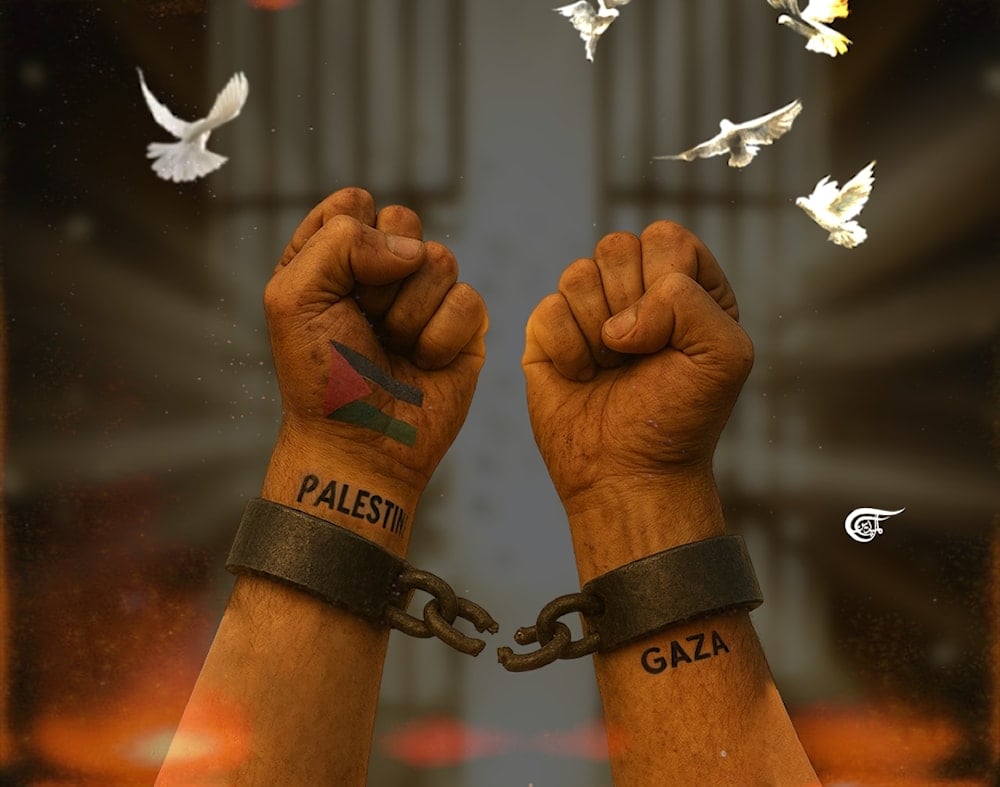4 prominent Palestinian detainees to be freed: Who are they?
As part of the Gaza ceasefire agreement, four Palestinian detainees with lengthy sentences, Mahmoud Issa, Nasri Assi, Ayman Abdul-Majid Seder, and Baher Mohammad Badr, are set to be released.
-

Illustration of fists breaking shackles, representing the liberation of Palestinian detainees from Israeli prisons. (Al Mayadeen English; Illustrated by Batoul Chamas)
In light of the first phase of the ceasefire agreement in Gaza, which took effect on October 9, several high-profile Palestinian detainees are set to be liberated after spending decades in Israeli occupation prisons.
Among the most notable figures released are Mahmoud Issa, Nasri Assi, Ayman Abdul-Majid Ashour Seder, and Baher Mohammad Badr, all of whom are considered symbols of steadfastness within the Palestinian national movement.
Commander Mahmoud Issa
Palestinian Resistance leader and senior figure in Hamas' military wing, Mahmoud Issa, from occupied al-Quds, has spent 28 consecutive years in Israeli prisons and has now entered his 29th year of detention.
Issa, 54, was sentenced to three life terms plus 46 years and is among the longest-serving Palestinian detainees, detained before the signing of the Oslo Accords. He endured one of the harshest isolation regimes in the occupation's prisons, spending 13 years in solitary confinement, 11 of them consecutively. Additionally, his family was denied visitation during the majority of this period, until a mass hunger strike in 2012 led to an end to his isolation.
Born in Anata, northeast of al-Quds, on May 21, 1968, Issa studied Islamic Law and Theology at Al-Quds University. He joined Hamas and later became a founding member of its military wing, establishing the first Hamas military cell in the al-Quds area, known as Special Unit 101, which carried out operations including attempts to capture occupation soldiers for prisoner exchanges.
Mahmoud Issa, Al-Quds-born, architect of resistance, and the “dean” of Hamas prisoners, is among the most feared and steadfast leaders the occupation has ever tried to break. Born in Anata, northeast of Al-Quds, in 1968, Issa joined Hamas upon its founding and, with a cadre of… pic.twitter.com/vVZXzBFE1u
— Thomas Keith (@iwasnevrhere_) October 11, 2025
Issa led the operation that captured Israeli Staff Sergeant Nissim Toledano on December 13, 1992, intending to exchange him for the release of Sheikh Ahmad Yassin. When the occupation rejected the demand, Toledano was killed. The operation was considered by the occupation as one of the most significant in the history of Palestinian Resistance, prompting an emergency session of the Knesset.
While imprisoned, Issa wrote several books, including Resistance: Theory and Practice, and Lessons for the Mindful: Tales from History. He also published works on the interpretation of the Holy Quran. Before his arrest, he worked as a journalist and served as director of the Sawt al-Hurriyah w-al-Haqq [Voice of Freedom and Truth] newspaper, which was active in the occupied territories.
Issa is currently held in the Israeli Nafha prison.
Nasri Assi
Another key detainee expected to be liberated is Nasri Assi. Born on September 27, 1977, in occupied al-Quds and raised in Beit Liqya near Ramallah, Assi was detained on July 17, 2005, just 45 days after his wedding.
Accused of affiliation with the Izz al-Din al-Qassam Brigades and involvement in a fedai operation, Assi was illegally sentenced by the occupation to 18 life sentences plus 70 years. He was held in Ramon Prison.
Assi was denied the chance to witness the birth of his first child and completed his high school education behind bars. His wife still holds onto hope for a future together beyond prison walls, a life they barely began.
Ayman Abdul-Majid Ashour Seder
Ayman Abdul-Majid Ashour Seder, a 57-year-old Palestinian from the town of Abu Dis, east of occupied al-Quds, has spent nearly three decades in Israeli prisons. He was detained on May 13, 1995, and sentenced to life imprisonment plus an additional 25 years.
At the time of his detainment, he was married with one son, Muhammad, who was only four months old. Seder was accused by the occupation authorities of being affiliated with the Izz al-Din al-Qassam Brigades, providing maps and intelligence for resistance operations, and facilitating access for fighters to their targets.
Seder was detained at the Beit Hanoun checkpoint while returning from Gaza. The Israeli occupation accused him of being a member of the Izz al-Din al-Qassam Brigades, providing maps and intelligence for Resistance operations, and facilitating access for fighters. He was subjected to over five months of intense interrogation at the al-Moskobiya (Moscovia) detention center and was classified among the most dangerous detainees. Following his detention, occupation forces sealed his home in Abu Dis with reinforced concrete.
Although he met the criteria, Seder was excluded from the 2011 "Wafa al-Ahrar" prisoner exchange deal.
Currently held in Ramon prison, Seder suffers from chronic kidney and joint problems. During the COVID-19 pandemic, he experienced a severe pulmonary embolism and was transferred to intensive care. Despite his condition, he continues to receive minimal medical attention, reflecting the broader policy of medical neglect in Israeli prisons.
Within the prison, Seder is widely respected for his national commitment and his active role in the educational and organizational efforts of the detainee movement.
Baher Mohammad Badr
Also from Beit Liqya, Baher Mohammad Badr, born on April 16, 1978, was detained by the Israeli occupation forces on April 7, 2004, at the age of 26, and has now spent over 21 years in prison. As a member of Hamas in his hometown, he was actively involved in the Resistance during the Al-Aqsa Intifada.
The occupation accused him of participating in a series of operations, including the 2004 Tzrifin bombing, the Café Hillel bombing in occupied al-Quds, and the Tel Aviv Central Bus Station bombing. After a prolonged search, he was eventually detained and sentenced to 11 life sentences.
Badr is currently serving his sentence in an Israeli prison, where he is regarded as one of the most prominent high-sentence detainees and a leading figure within the Palestinian prisoner movement.
Badr is 30 years old, and was kidnapped and spent a month in Israeli prisons being tortured.
— JonnyUtd (@Fx1Jonny) June 20, 2024
He has come out a completely different person who clearly now suffers from severe mental health problems because of what they did to him. Horrific to watch 💔
pic.twitter.com/30QclAPHGN
"Israel" currently detains approximately 5,000 Palestinians in its jails, reflecting the ongoing policy of mass incarceration targeting the Palestinian population. Among them are around 600 individuals serving long sentences, including multiple life terms. The occupation also holds 425 Palestinians under administrative detention, imprisoned without charge or trial. Additionally, around 200 children and 45 women are currently behind bars, many of whom face harsh and inhumane conditions in violation of international law.
In Israeli prisons, all Palestinian detainees are subjected to widespread and systematic violations, including torture, solitary confinement, and denial of family visits. Most face legal harassment and policies intended to increase psychological and physical pressure.
It is worth noting that detainees from al-Quds are held across multiple Israeli prisons, with the majority confined in the al-Naqab, Megiddo, and Gilboa facilities. Female detainees are primarily held in Damon and Hasharon prisons, while child detainees are often placed in Ofek prison, where they are detained alongside criminal offenders.
First phase of Gaza ceasefire plan
Israeli media outlets reported that seven Israeli captives released by Hamas under the first phase of US President Donald Trump's ceasefire plan in the Gaza Strip have been handed over to the International Committee of the Red Cross (ICRC) and are reportedly in good condition.
Earlier this morning, the Israeli army stated that ICRC vehicles arrived at an agreed-upon location in the northern Gaza Strip to receive the released captives. This development comes after days of ongoing negotiations mediated by Egypt, Qatar, and the United States. Moreover, Red Cross buses also headed to Gaza's Khan Younis to receive the second batch of Israeli captives.
The Israeli military confirmed its readiness to receive the additional captives, stating that more captives were expected to be transferred to the Red Cross later in the day.
According to Channel 13, the prisoner handover was scheduled to begin at 8 am in the Netzarim area, followed by another transfer at 10 am in Khan Younis. The process is being carried out under international supervision.

 7 Min Read
7 Min Read









